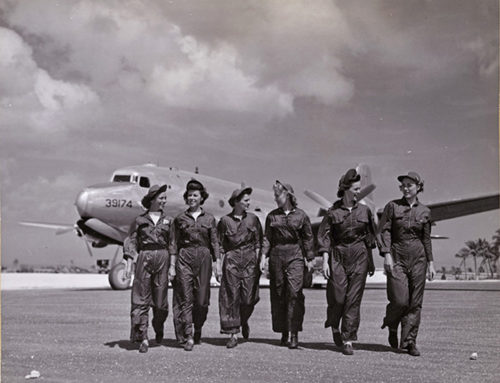USS NAUTILUS (SSN-571) may have proved the value of nuclear power to naval propulsion, but her hull shape reflected the traditional surface-ship design that worked well for vessels that spent most of their time atop the waves. It was USS ALBACORE (AGSS-569) which pioneered the teardrop-shaped hull that, when combined with nuclear power, would revolutionize the submarine force. We’ll learn more about this unique boat and her unusual final resting place in this week’s “Tidbits.”
Over the course of World War II, the American submarine force, comprising 269 boats, made nearly 1,700 patrols and spent a total of almost 72,000 days at sea. On average, the force sent an enemy vessel to the bottom every four days. For a part of the Navy that was, at the start of the war, only forty years old, the awkward kid brother of the 166-year-old surface fleet, this was a major accomplishment. But all that time spent on patrol revealed serious weaknesses. Boats were limited in range by the amount of diesel fuel they could carry and were limited in the time they could spend below the surface by the amount of charge they could store in their batteries. In addition, the boats’ knife-edged, flared bows worked well when they were on the surface, where they spent much of their time, but slowed them down considerably when they were submerged. Changes would need to be made. The ultimate goal: a true submersible that could operate quickly and nearly indefinitely underwater. While Captain Hyman Rickover focused on the endurance portion of that goal by working to develop a sub-sized nuclear reactor, Admiral Charles “Swede” Momsen tackled the speed issue—the National Academy of Science’s Committee on Undersea Warfare called for 20 knots—by considering a radical new hull design.
Momsen won funding for his project by claiming the boat would be a good target for antisubmarine practice. By specifying that she would not be armed, he avoided involving various bureaus that would, he claimed, have stuffed the new sub “like a turkey,” although instead of cornbread they would have packed in all manner of gadgets and gizmos and widgets. “Forget about surface performance,” he told his engineers. “Think only about submerged capability which will provide the utmost speed with minimum of power. When in doubt, think speed.” The men did as they were told, studying shapes from the sea and the air to determine what would move the fastest. They settled on a design with a blimp-like bow and a tapered, fish-like tail. The boat would be made of HY-80, the strongest steel available, and have a single screw rather than the two most subs sported, mostly for maneuverability on the surface where this boat wouldn’t be spending much time.
In a remarkably short period, concept became reality: the 204-foot USS ALBACORE (AGSS-569) was commissioned on 5 December 1953, just three years after Momsen took up the challenge. (Rickover would not commission NAUTILUS for another ten months.) The boat’s motto was remarkably prescient: “Praenuntius Futuri,” or “Forerunner of the Future.”
Unfortunately for many of the admirals who had approved ALBACORE’s funding, she was an awful target. She could reach speeds of up to 27 knots and maneuver like a finely-tuned sports car. Because a single man controlled the boat with a single yoke, a total of only three men was required to operate her—a conning officer, a pilot, and a crewmember who operated key manifolds—as opposed to the ten required by the other subs of the time. Her only real headache—which was, admittedly, a big one—was her engines, newly-designed pancake diesels that had trouble charging the sub’s batteries and were in constant need of repair. ALBACORE’s crew nursed the temperamental engines through nineteen years of service by pulling parts off ones that had come from TANG-class boats.
Those committed crewmen, about 55 of whom were assigned to the boat at any given time, contended with living conditions that were more Spartan than those on other subs. “Hot racking,” or bunk sharing, was common. Crew’s mess contained only three tables that seated a total of 18 people at a time. And there were always extra personnel aboard conducting tests or experiments and taking up space. The rounded hull made travel on the surface rocky, especially in bad weather. “I can remember we ran into a hurricane on our way home from Florida,” former yeoman Butch Jordan recalls. “Heavy waves were pounding us and coming over the top of the sail. …Water was coming into the boat through the main air induction and filling the machinery space bilges. …The control room watch observed the digital depth gauge cycling between 9 and 60 feet—while running on the surface!” One imagines that Commissaryman Henry “Shakey” Graves elected not to serve his famous Lobster Newberg that day.
But ALBACORE certainly had her positives. “I actually learned to fly on the Albacore,” says former Electronics Technician Jim Tyrell. “A few years after I got out of the Navy, I took flying lessons. The instructor was amazed I could fly a plane the first time I tried. It felt exactly like flying the Albacore.” Tyrell also recalls the formation of a not-quite-authorized “human trim party.” “We had a new officer learning how to trim the boat and six of us would walk from the bow compartment aft to the machinery space which would throw his trim off. By moving aft, the six of us were making the bow of the boat about 1000 pounds light and the aft end 1000 pounds heavy. We would wait awhile until he got the trim perfect before walking forward to the bow compartment. Pretty soon the trim pump would start up to adjust the trim. We would head aft again to mess up the trim. Finally the Chief of the Watch told on us and we were ordered to stay in one place.”
Thanks to Friends of ALBACORE for the quotations from former crewmembers.
Check out “Tidbits” tomorrow and Wednesday for two ALBACORE sea stories. On Thursday we’ll learn how she ended up in a concrete cradle a quarter-mile inland.





